Published Jan 13, 2015
The 9 Deepest Deep Space Nine Magazine Covers
The 9 Deepest Deep Space Nine Magazine Covers
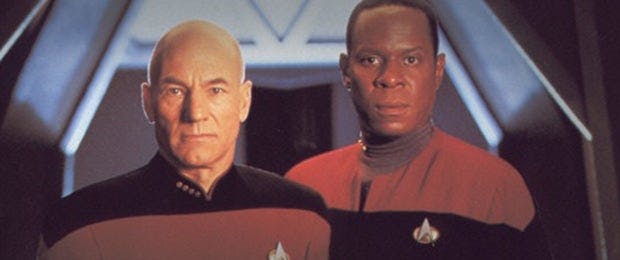
Out beyond the Wormhole, they’re probably still selling the Starlog Group’s Official Magazine at the Promenade comic book store on Deep Space Nine. Mint condition. In Special Collectors’ Edition Mylar Bags. Autographed by Benjamin & Jake Sisko, Odo, Major Kira, Worf, Dax, Miles & Keiko O’Brien, Dr. Bashir, Garak, Rom, Nog and Morn. And for a small additional fee (payable in gold-pressed latinum), signed and numbered by Quark.
Or at least that’s what I imagine. I was Editor of the Starlog Group-published Official Star Trek: Deep Space Nine Magazine, which lasted six seasons (four issues per season, plus a bonus wrap-up edition). In 1998, Starlog Publisher Norman Jacobs declined to renew the company’s license with Paramount for the syndicated series’ seventh (and final) season, citing rising costs and declining revenues. Alas, our DS9 Magazine was never as popular as its Next Generation sister publication (was it the covers, the contents or the show itself?). Incidentally, it shouldn’t be confused with Titan Books’ Official DS9 Poster Magazine, a short-lived monthly published in Great Britain (with limited distribution in the U.S.).
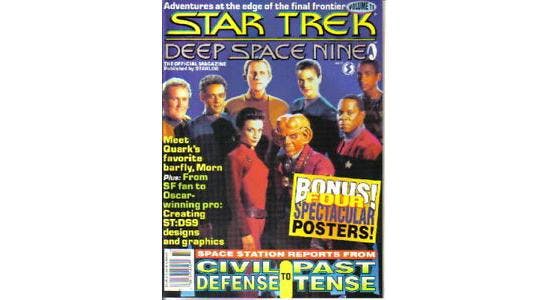
Our DS9 magazine launched with the TV show in January 1993. Volume 1 sported a classy cover, braced by, typically, too many coverlines. Did "Welcome to the world of Star Trek: Deep Space Nine" really sell magazines? It’s a nice cast shot—to which we added that classy gold background. That was a costly decision by Jacobs. It’s what’s known as a "fifth hit." Printing magazines with glossy color pages involves a complex, high-speed press using four printing plates (black, red, yellow, blue). Those latter three "primary colors" blend, as you’ll recall from fingerpainting in kindergarten, to create orange, green, purple and other shades. Philosopher’s Stone notwithstanding, nothing combines to make gold and silver. Instead, special metallic inks have to be employed, adding a fifth plate to the process (requiring a second run through the press just for the gold-inked portions). This added a sizable cost to the print bill. Nonetheless, it still gives this cover a small strain (stain?) of sophistication.
Inside, we followed the blueprint originated for our Next Gen Magazine (which I also edited): DS9 episode synopses (scripts turned into short stories, mostly by John Sayers with a few by Doc Savage novelist Will Murray) and interviews with the show’s actors, writers, directors and fellow creatives (by my usual team of Starlog contributors, Ian Spelling, Joe Nazzaro, Bill Florence, Pat Jankiewicz, etc.). Some issues also included foldout posters. The magazine’s interior contents, I maintain, were always better than the covers. I like to think we kept the quality up inside (as far as words, pictures and designs go), but outside was a different story, hence this regretful essay.
I planned to eventually give every DS9 series regular a solo cover. Alas, Cirroc Lofton (Jake Sisko) never ended up with a cover to himself, one that, as a regular, he deserved. And Nicole de Boer missed out entirely as Ezri Dax, because we didn’t do the seventh season. Also never fronting the publication were a few notable DS9 recurring figures like James Darren (Vic Fontaine), Max Grodenchik (Rom), Aron Eisenberg (Nog) and Marc Alaimo (Gul Dukat, subject of a past Starlogging column). Sorry! All the others—including Colm Meaney (O’Brien) and Andrew Robinson (Garak), whose issues (Volumes 5, 9) are not pictured here—got covers of their own.
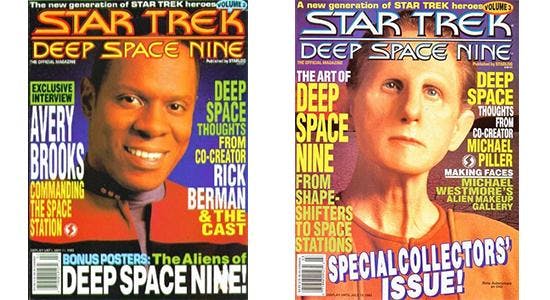
We began with Avery Brooks as Benjamin Sisko on Volume 2. Nice. Look how Starlog Creative Director W.R. "Bill" Mohalley (who designed all 25 covers) made this one "pop" by using different colors (green, white, yellow) on text blocks (a trick which then doesn’t actually work on Volume 14, see next graph). Volume 3 features Rene Auberjonois as Odo and an eerie alien background that Mohalley added to replace the original (a design choice which works here, but doesn’t, as we’ll discuss, on Volume 22). But both covers and their images are haunted by our continual problem of too many coverlines. Words, words, words! As Jacobs directed, we were always trying to find more ways to "sell" (i.e. get the attention of casual and new readers on the newsstand). The tendency was to ballyhoo every potential commercial selling point about an issue on its cover. This was, I must admit, partially my fault; I wrote the coverlines (aided and abetted by my Managing Editors). Continuously unhappy with the too-wordy look that resulted, I tried composing fewer, shorter coverlines. And guess what? Mohalley responded by making those fewer words BIGGER. Yes, he did. And Jacobs liked it, so I was duly overruled. Truly, a self-defeating stratagem.
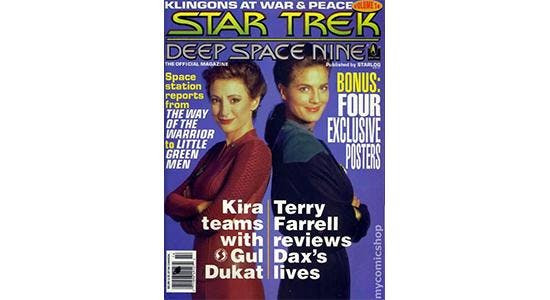
Major Kira (Nana Visitor) and Jadzia Dax (Terry Farrell) are back-to-back on Volume 14’s cover. This image was from a special photo shoot Paramount did. It was sent to us as a nifty oversize transparency, allowing for better photo reproduction. Since 2000 or so, publicity pictures have been provided to the media in digital formats (not the slides, transparencies and still photos of yesteryear), so beautiful reproduction in print magazines or on websites like StarTrek.com is now mere routine. But look what mangles (in my view) this 1995-6 cover: the two main coverlines are both in white—so they can be mistakenly read not down but across, producing a singular mass of gibberish—and they’re plastered on the bodies. I personally prefer that lines (and the magazine logo) not touch or trespass on faces and figures, thereby creating a 3-D-look. Obviously, as you can tell by all the printed evidence, Jacobs and Mohalley didn’t share that belief, only occasionally humoring me. But imagine if those lines on Kira and Dax were in different colors (one in white, the other yellow) and/or if the text blocks were somehow not affixed to their torsos. The lines would read as separate thoughts. The figures would pop. The cover would be better. At least, I think so.
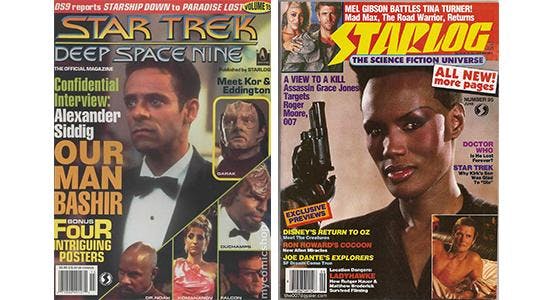
Looking at Volume 15 now, I am shaken not stirred. It’s a terrific idea to go all-out James Bond for a cover featuring Alexander Siddig as "Our Man Bashir" (from that thoroughly enjoyable, holographic superspy adventure). But the execution? Feeble! And why didn’t we come up with more espionage-tinged "verbiage" (as Jacobs termed coverlines)? Another "For Your Eyes Only" or "Intelligence Dossier" line—or anything else out of Bond, Our Man (Derek) Flint, Matt Helm, the Man from U.N.C.L.E., Nick Fury, Agent of S.H.I.E.L.D. or even Austin Powers.
I petitioned Paramount Licensing for a sharper, all-body shot of Siddig in his tuxedo aiming a gun at someone or posing, Bond-like, weapon aside his face. After all, that’s the kind of photo often seen in Starlog Magazine’s abundant 007 coverage. Starlog Press also did licensed 007 publications for Moonraker, Octopussy, A View to A Kill, The Living Daylights, Tomorrow Never Dies and The World is Not Enough. I worked on Octopussy and then served as Editor of the next four (and Mohalley did those last four Bond covers; unusually, he also designed all the interior pages of A View to A Kill). So, we had Bond expertise, but, of course, we couldn’t repurpose trademarked 007 imagery (like the opening iconic gun-barrel iris shot that Bond movie titles designer Maurice Binder devised). I met Binder and had in my office files lotsa Bond graphics he supplied (to illustrate a two-part Starlog interview with Binder by Marvel Comics writer Don McGregor). However, to use one studio’s imagery to create something for another studio—that way lies certain madness and possible litigation. But if Paramount had provided an appropriate shot? Sadly, Paramount’s photographers never snapped the brand of Bondesque pix I desired. Missed opportunity! This cover (as shown)—complete with portraits of Bashir’s secret agent friends and foes—is the best we could cobble together. And a bloody mess.
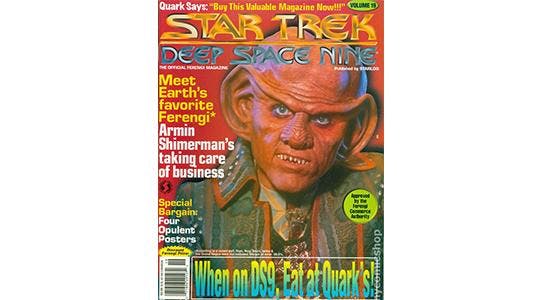
My favorite DS9 cover is Volume 19, "The Official Ferengi Magazine," proudly displaying Quark (Armin Shimerman). It’s infested with (hopefully) humorous coverlines like "Quark Says: ‘Buy This Valuable Magazine Now!!!’ " The major line declares "Meet Earth’s Favorite Ferengi*" That asterisk footnotes a disclaimer (in such small print you can barely read it) that subtly mocks Quark’s achievement: "According to a recent poll. Rom, Nog, Brunt, Ishka & the Grand Nagus were not included." It even boasts an advertising slogan: "When on DS9, Eat at Quark’s!" This was the most fun we had with DS9 coverlines—and I was surprised that both Jacobs and Paramount Licensing permitted such playfulness. Apparently, the mischievous idea to also list a "gold-pressed latinum price" with the UPC code was one in-joke too far. It was thought that being too cute about prices might befuddle hapless store clerks trying to ring up a sale. The more generic "Discount Ferengi Price" replaced it. Remember Ferengi Rule of Acquisition #1: "Once you have their money, you never give it back."
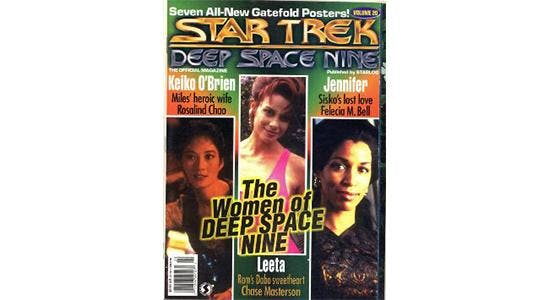
"The Women of DS9" rule Volume 20. For this issue, they aren’t Kira and Dax, but Keiko O’Brien (Rosalind Chao), Leeta (Chase Masterson) and Jennifer Sisko (Felecia M. Bell). This wasn’t a planned cover; we suddenly had interviews with all three actresses on hand so my big, creative (?) decision was, "Let’s run ’em all in one issue!" with an umbrella theme coverline. There’s something classic and pleasing about this cover. It works. However (and there’s always a however with me), I wonder now if branding an issue "The Women of DS9" was just inherently sexist. After all, we never cover-featured "The Men of DS9." But we did (sorta) do "The Aliens of DS9" with the next issue’s "Klingons, Vortas & Ferengi" showcasing General Martok, Weyoun and Grand Nagus Zek (and interviews with J.G. Hertzler, Jeffrey Combs and Wallace Shawn).
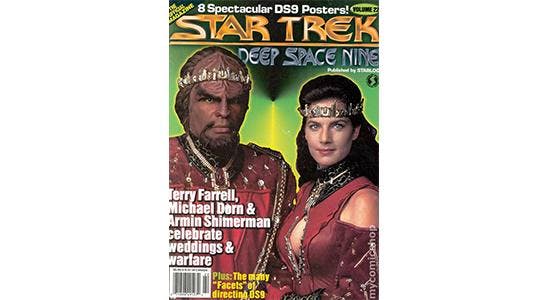
Volume 22 celebrates DS9’s Wedding of the Century between Klingon and Trill -- an uncertain Worf (Michael Dorn) and a hopeful Jadzia Dax (Farrell). It’s a portrait of comparative simplicity. There’s all the standard cover wordage, but otherwise just two main coverlines (hallelujah!). That’s a neat photo (from an oversize transparency and another special Paramount TV photo shoot). Alas, the moment Jacobs saw it in our cover meeting, he announced, "We’ll have to lose the background!" So, the grey backing that the photo arrived with was deleted and this sickly green, laser-pointy background substituted to "add interest" to the image. Yuck! I think it only detracts (and distracts) from Worf and Dax. See, even when we get a great picture, some other element ends up tarnishing the sight. Flaws, flaws, flaws!
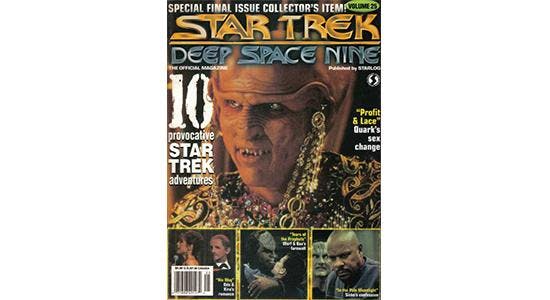
Frankly, it disturbed my fanboy sense of completeness that Starlog Group might not "finish out" that season. So, I petitioned Jacobs for a fifth issue to wrap it all up: "Please, sir, can I have one more?" And since our contract didn’t limit the number of issues per year, Jacobs let me do the "Special Final Collector’s Item," Volume 25. Thanks, Norm. Published in late summer 1998 (to allow inclusion of the June season finale, "Tears of the Prophets"), this edition doesn’t have any interviews. We needed all the space for the last 10 synopses.
I intentionally didn’t call this "Our Nine Best DS9 Covers" (because there aren’t that number of bests), but these are the ones I have the deepest thoughts about. In retrospect, studying all 25 Star Trek: Deep Space Nine Official Magazine covers today, 20 years after we began the adventure, I really don’t like any of them all that much. Sigh. Volume 1’s cover is classy, 19, clever and 20, classic. But, otherwise, in my opinion, the covers mostly came out clunkers.
___________
David McDonnell, "the maitre’d of the science fiction universe," has dished up coverage of pop culture for more than three decades. Beginning his professional career in 1975 with the weekly "Media Report" news column in The Comic Buyers’ Guide, he joined Jim Steranko’s Mediascene Prevue in 1980. After 31 months as Starlog’s Managing Editor (beginning in October 1982), he became that pioneering SF magazine’s longtime Editor (1985-2009). He also served as Editor of its sister publications Comics Scene, Fangoria and Fantasy Worlds. At the same time, he edited numerous licensed movie one-shots (Star Trek and James Bond films, Aliens, Willow, etc.) and three ongoing official magazine series devoted to Trek TV sagas (The Next Generation, Deep Space Nine, Voyager). He apparently still holds this galaxy’s record for editing more magazine pieces about Star Trek in total than any other individual, human or alien.
Copyright 2015 David McDonnell
